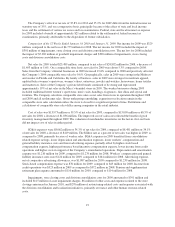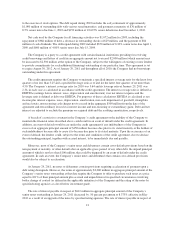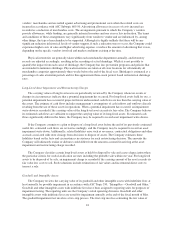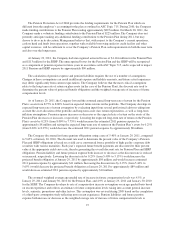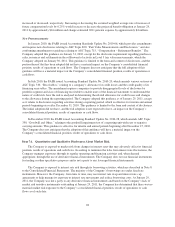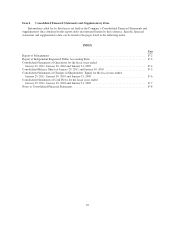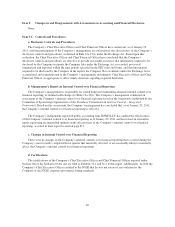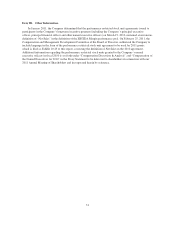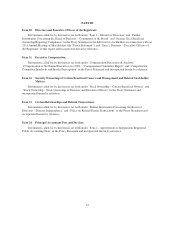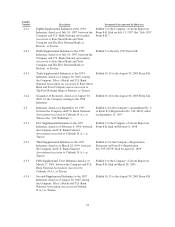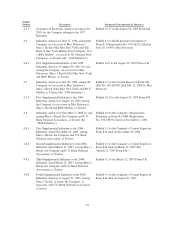Macy's 2010 Annual Report Download - page 31
Download and view the complete annual report
Please find page 31 of the 2010 Macy's annual report below. You can navigate through the pages in the report by either clicking on the pages listed below, or by using the keyword search tool below to find specific information within the annual report.each reporting unit based on its estimated discounted cash flows and comparing the estimated fair value of each
reporting unit to its carrying value. If this comparison indicates that a reporting unit’s estimated fair value is less
than its carrying value, a second step is required. If applicable, the second step requires the Company to allocate
the fair value of the reporting unit to the estimated fair value of the reporting unit’s net assets, with any fair value
in excess of amounts allocated to such net assets representing the implied fair value of goodwill for that reporting
unit. If the carrying value of an individual indefinite-lived intangible asset exceeds its fair value, such individual
indefinite-lived intangible asset is written down by an amount equal to such excess.
The Company uses judgment in assessing whether assets may have become impaired between annual
impairment tests. The occurrence of a change in circumstances, such as continued adverse business conditions or
other economic factors, would determine the need for impairment testing between annual impairment tests. Due
to deterioration in the general economic environment during 2008 (and the impact thereof on the Company’s
then-most recently completed annual business plan) and the resultant decline in the Company’s market
capitalization, the Company believed that an additional goodwill impairment test was required as of January 31,
2009. In performing the first step of this impairment test, the Company estimated the fair value of its reporting
units by discounting their projected future cash flows to present value, and reconciling the aggregate estimated
fair value of the Company’s reporting units to the trading value of the Company’s common stock (together with
an implied control premium). The Company believes that this reconciliation process represents a market
participant approach to valuation. Based on this analysis, the Company determined that the carrying value of
each of the Company’s reporting units exceeded its fair value at January 31, 2009, which resulted in all of the
Company’s reporting units failing the first step of the goodwill impairment test. The Company then undertook
the second step of the goodwill impairment test, which involved, among other things, obtaining third-party
appraisals of substantially all of the Company’s tangible and intangible assets. Based on the results of its
goodwill impairment testing as of January 31, 2009, the Company recorded a pre-tax goodwill impairment
charge of $5,382 million ($5,083 million after income taxes) in the fourth quarter of 2008. As a result of the 2008
goodwill impairment charge, the Macy’s retail operating division is the only reporting unit with goodwill.
Based on the results of the most recent annual impairment test of goodwill and indefinite-lived intangible
assets completed during the second quarter of 2010, the Company determined that goodwill and indefinite-lived
intangible assets were not impaired as of May 29, 2010 and the estimated fair value of the Macy’s retail
operating division substantially exceeded its carrying value.
The goodwill impairment testing process involves the use of significant assumptions, estimates and
judgments by management, and is subject to inherent uncertainties and subjectivity. Estimating a reporting unit’s
discounted cash flows involves the use of significant assumptions, estimates and judgments with respect to a
variety of factors, including sales, gross margin and SG&A rates, capital expenditures, cash flows and the
selection and use of an appropriate discount rate. Projected sales, gross margin and SG&A expense rate
assumptions and capital expenditures are based on the Company’s annual business plan or other forecasted
results. Discount rates reflect market-based estimates of the risks associated with the projected cash flows of the
reporting unit directly resulting from the use of its assets in its operations. The allocation of the estimated fair
value of the Company’s reporting units to the estimated fair value of their net assets also involves the use of
significant assumptions, estimates and judgments. Both the estimates of the fair value of the Company’s
reporting units and the allocation of the estimated fair value of the reporting units to their net assets are based on
the best information available to the Company’s management as of the date of the assessment.
The use of different assumptions, estimates or judgments in either step of the goodwill impairment testing
process, including with respect to the estimated future cash flows of the Company’s reporting units, the discount
rate used to discount such estimated cash flows to their net present value, the reasonableness of the resultant
implied control premium relative to the Company’s market capitalization, and the appraised fair value of the
reporting units’ tangible and intangible assets and liabilities, could materially increase or decrease the fair value
of the reporting unit and/or its net assets and, accordingly, could materially increase or decrease any related
impairment charge.
25






